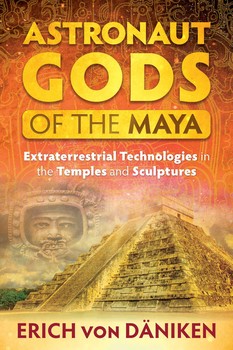Get our latest book recommendations, author news, competitions, offers, and other information right to your inbox.
Astronaut Gods of the Maya
Extraterrestrial Technologies in the Temples and Sculptures
Table of Contents
About The Book
Excerpt
Cargo Cults with Aftereffects
The ruin sites of Tikal lie in current-day Guatemala; its beginnings go back to approximately 1000 B.C. (Remember: Ancient Rome was supposedly founded in 753 B.C.) One of the steles of Tikal is known as “pre-classical stele,” and its origination has been disputed. Today it is in a small museum with other ruins of Tikal. The head of the stele has been cut off, but one can recognize the chest, two bent elbows, decorated forearms, and both hands, which clearly have boxinglike gloves. Below, experts recognize a horizontal crest with double snake heads. The middle of the statue contains the spinal cord, then--still lower--a wide belt, thighs, and finally the feet. Scholars recognize a loincloth covered with jade pearls and sandals on the feet. The arms seem to hold a form of a ceremonial rod, which ends in small snake heads.
But how objective is this description from the “experts”? We can clearly see wide bands that lie around the wrists, and the gloves could be recognized even by a child. In order to highlight the technical particulars, I have colored the image a bit. The supposed “spinal cord” could be a bent tube that empties into a small box. A spinal cord must run perpendicular to the coccyx. In reality, the feet are in boots, and out of each boot winds a curious hose. The Maya themselves were barefoot or wore sandals. What were the boots with the hoses? Is the creator of the heavenly family really shown here? Are bracelets, gloves, spinal cord, small boxes, boots, and hoses not just other misunderstandings of technology? Had the artist carved something with holy respect into the stone, which he himself did not understand?
The question is absurd, because the world of the Mayans did not have countless related representations at which to marvel. In Guatemala, not far from the Pacific coast, is the small village El Baúl. I found the village’s attraction in an open, wind- and weatheraffected wooden shed near a sugar factory. The El-Baúl-Monument No. 27, as the location is officially known, is 2.54 meters (8'4") tall and 1.47 meters (4'10") wide. Centuries ago it was accidentally found in a forest clearing and left there. The stele shows a dominating form that holds its hands on its hips. The hands seem to be protected by boxing gloves, and in each hand the figure holds a tennis ball–sized ball. Thoroughly modern, the feet of the figure are in boots that reach to the knees and cover knickerbocker-like pants. A wide belt separates the pants from a sharply angled upper body. This figure--if you believe it—was dressed in the fashion of its time. But the helmet, which covers the entire head, is perplexing. Like a diving outfit, it has large coils on the shoulders. From the helmet, a tube reaches to a box, similar to a tank, on the back. When observed closer, one recognizes a peephole in the helmet, and behind it, the nose and left eye of the helmet wearer.
It gets stranger. In direct extension of the nose, but outside of the helmet, the stone mason modeled an animal snout, maybe that of a jaguar. Out of the snarling jaw blows--as if pushed out--a cloud of breath from the helmet wearer.
According to experts, the relic represents a scene from the deadly ball game of the Maya. The winner wore the mask of a monkey, jaguar, or possibly also an opossum. Therefore the “hose” from the helmet to the tank is nothing other than the tail of a small opossum, and the expressed air symbolizes water, since the opossum is a water animal.
An academic explanation--though ultimately as imaginative as my meaning. Why would a ball player put on the mask of an animal since it would only hinder them? The Maya played an extremely fast game. The players’ eyes must react lightning-fast. The face behind the mask is given only a limited view. And why should the player hang the tail of an opossum behind the oversize ears of the helmet? What is the tank on the back? For comparison: The ball player of Chichén Itzá (Mexico) carried neither animal masks nor possum tails behind their ears. Let alone these vessels on their backs.
I have a different interpretation. What the predecessors of the Maya thought was a “god” was actually an extraterrestrial. He wore a closed helmet with a view. This is because of earthly composition and bacteria. From one tank on the back, a chemical mixture flowed out, which enriched or disinfected our air. The consumed air was outcast again. The entire body stays in narrow, impenetrable overalls, finished with high boots. Just as was true for the artists in Christian churches, the stonemason of Monument No. 27 from El Baúl has never come face to face with this “god.” This meeting lay far, far in the past. The detailed work of the artist originated from the fantasy of custom, similar to current artists that draw Jesus on his ascension over a stone altar even though they were not present for the actual event.
Product Details
- Publisher: Bear & Company (September 21, 2017)
- Length: 272 pages
- ISBN13: 9781591432357
Browse Related Books
Raves and Reviews
“Over the past five decades Erich von Däniken has taken his readers to remote corners around the world in search of aliens. In this book he explores the archaeological mysteries of the Maya and their startling similarities in other cultures around the ancient world. Illustrated with over 200 of his color photographs, you’ll explore a world you never knew existed. Whoever still doubts that Earth was visited by flesh and blood extraterrestrials in the remote past needs to read and absorb this book to conclude: we are not alone. In fact, we never were. The lush pictorial evidence presented here speaks for itself. Put on your hiking boots, because you’re going on an adventure!”
– Giorgio A. Tsoukalos, publisher of Legendary Times Magazine
Resources and Downloads
High Resolution Images
- Book Cover Image (jpg): Astronaut Gods of the Maya Trade Paperback 9781591432357












